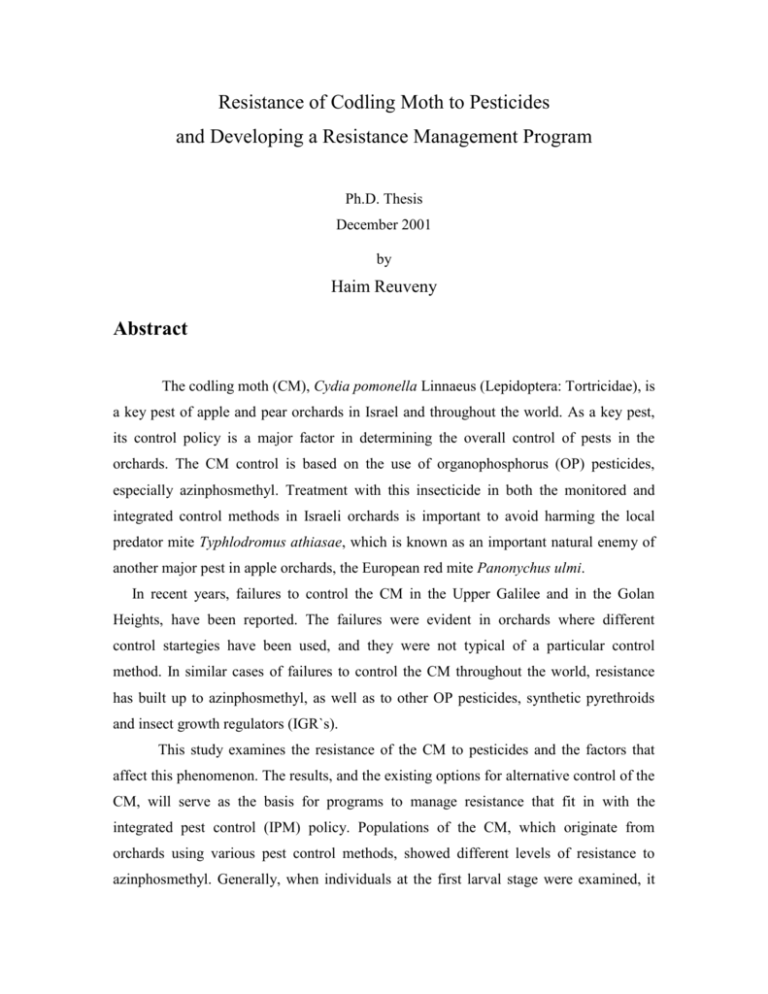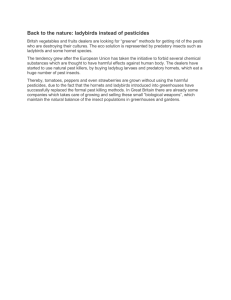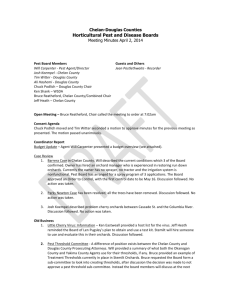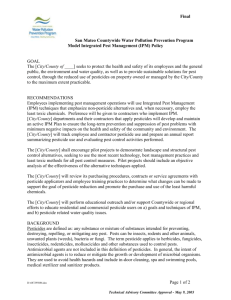Resistance of Codling Moth to Pesticides
advertisement

Resistance of Codling Moth to Pesticides and Developing a Resistance Management Program Ph.D. Thesis December 2001 by Haim Reuveny Abstract The codling moth (CM), Cydia pomonella Linnaeus (Lepidoptera: Tortricidae), is a key pest of apple and pear orchards in Israel and throughout the world. As a key pest, its control policy is a major factor in determining the overall control of pests in the orchards. The CM control is based on the use of organophosphorus (OP) pesticides, especially azinphosmethyl. Treatment with this insecticide in both the monitored and integrated control methods in Israeli orchards is important to avoid harming the local predator mite Typhlodromus athiasae, which is known as an important natural enemy of another major pest in apple orchards, the European red mite Panonychus ulmi. In recent years, failures to control the CM in the Upper Galilee and in the Golan Heights, have been reported. The failures were evident in orchards where different control startegies have been used, and they were not typical of a particular control method. In similar cases of failures to control the CM throughout the world, resistance has built up to azinphosmethyl, as well as to other OP pesticides, synthetic pyrethroids and insect growth regulators (IGR`s). This study examines the resistance of the CM to pesticides and the factors that affect this phenomenon. The results, and the existing options for alternative control of the CM, will serve as the basis for programs to manage resistance that fit in with the integrated pest control (IPM) policy. Populations of the CM, which originate from orchards using various pest control methods, showed different levels of resistance to azinphosmethyl. Generally, when individuals at the first larval stage were examined, it was found that populations in a preventative pest control regime were more resistant in comparison to the other populations. The level of resistance in an increasing order (according to the ratio LC50 values between field and laboratory populations) was a follows: Preventative Pest Control > IPM Control > Organic Pest Control > Labaoratory Population. When the contribution of each orchard in a particular pest control method was examined, it was found that the high resistance in the preventative method, was in two out of five orchards. The low resistance in the organic pest control method was in one out of two orchards. In the rest of the orchards controlled by various methods, no differences were found in their resistance level. It is worth mentioning that in the organic orchards neither azinphosmethyl nor other pesticides have been used. These data indicate that the level of resistance in the different orchards is a result of the pest control policy, as well of migration from neighboring orchards. The resistance to azinphosmethyl was found in both adults and larvae. Adults were also resistant to chlorpyrifos (OP), and larvae to IGRs. The level of resistance in insects (both larvae and adults) not exposed to azinphosmethyl, was reduced by 30%-50% after 15-17 generations. In testing enzymatic systems such as acetylcholinesterase (AChE), non-specific esterases (esterases) and glutathione-S-transferase (GST) in adults, no differences was found that may indicate any effect of the pest control policy. The use of the synergist DEF indicated that esterases are involved in resistance to the OP insecticide. The affinity (Km) of the substrate to AChE was lower in populations resistant to azinphosmethyl. This information indicates a structural change of AChE in resistant populations. The phenomenon of substrate inhibition in AChE enzymes was evident, as high acetylthiocholine concentrations were inhibitory. This phenomenon was not demonstrated with either propionyl- or butyrylthiocoline as substrates. Strong inhibition (Ki~10-8M) of the insect enzyme in the presence of the ammonium quaternary BW284c51 and the OP MEPQ were found,. However, no inhibition by high levels isoOMPA (10-4M) was apparent. These results were similar in insects from both resistant and sensitive populations. chloripyrifos-oxon was the strongest OP inhibitor followed by azinphosmethyl-oxon and paraoxon. In the presence of the above three OP inhibitors, no diferences in IC50 values of resistant and sensitive populations were evident. Based on the results, the plan for the CM resistance management includes effective means for monitoring and possible delaying further development of resistance. Also they may help in selecting effective means that fit with the IPM approach for controlling the pest. The most efficient and convenient method to monitor resistance is by exposing the first instar larvae to artificial food treated with the pesticide. It is recommended to collect the fifth instar larvae in the field by using corrugated cardboard strips around the trunk, at the time when the insects are looking for suitable winter sites. The method is preferrable for testing pesticides that have a different mechanism of action, and it is possible to gain information on the resistance level before appearance of the first generation in the following season. In this way, it is possible to plan ahead of time pest control strategies. In the light of the findings that show resistance of the CM populations to a variety of pesticides, and assuming that the rate of decrease in resistance takes a relatively long time, it is recommended to refrain from using chemical insecticides. The pest control strategy should include means that will maintain a low level of the pest in order to prevent future eruptions of resistant populations as a result of immigration of individuals from orchards and wasteland. The familiar and effective way for maintaining a low level of the CM is by the mating disruption (MD) method. It is reasonable to assume that applying the MD over large areas will prevent the possibility of the pest eruption. The core of the CM resistance management plan is based on keeping low levels of populations. The program is ineffective when the population level is high. In such cases it is possible to firstly reduce the poplation level using MD and OP together, to be followed later by a resistace management program.









